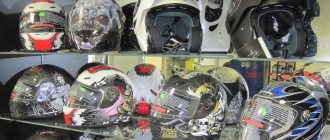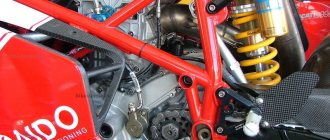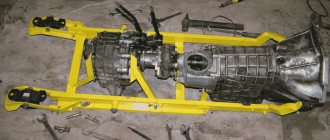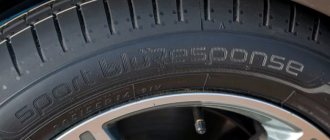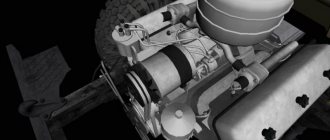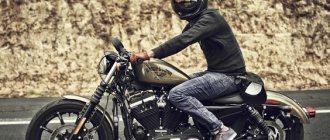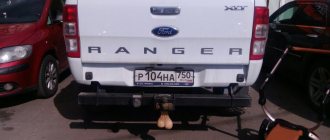Motorcycle helmet: deciding on the size
You are buying a motorcycle helmet for the first time or want to change the brand of helmet. How to determine what size to focus on? How can you make sure that the helmet you try on in the store is the perfect size and shape for you?
- Using a tailor's centimeter or soft tape measure, measure the circumference of your head at the widest part (if you don't have a centimeter, attach a braid or rope to your head, and then measure the resulting length with a ruler). As a rule, you need to measure your head circumference at a distance of 1.5-2.5 centimeters above the eyebrows, slightly above the ears and at the point on the back of the head that gives you the greatest circumference (see pictures). Measure your head several times to avoid mistakes and find the maximum circumference. In any decent store, where qualified and knowledgeable salespeople work, they will determine the right size for you using the same method. But there is no guarantee that the seller will be attentive and polite. In addition, you need to clearly know your size if you order a helmet from a catalog.
- Now compare the result obtained with the helmet sizes indicated in the summary tables below - each helmet size corresponds to a certain head circumference in centimeters and/or inches. Because different manufacturers make hard shells in completely different shapes and sizes, they may classify their helmet sizes differently. Below on this page there are tables of helmet sizes corresponding to head circumference length, depending on the helmet brand/manufacturer. If you are firmly convinced that you want to buy a helmet from a specific brand, for example, Arai or Shoei, see the corresponding table (or read the recommendations on the manufacturer’s website).
- If you see that two helmet sizes may fit you, it is preferable to go with the smaller size. 3.1. Firstly, safety requirements (and you buy a helmet precisely for your own safety, and not for beauty - or not only for beauty) are that the helmet sits very tightly on your head (but does not cause pain) - otherwise the degree of its protection will be significantly less, or during a fall from a motorcycle the helmet will completely fall off the head. 3.2. Secondly, now you determine only the theoretical size, and in the store you can choose the most suitable size.
Right size. The last check is very important, but unpleasant. The helmet strap must be fastened. Grasp the back edge of the helmet with your hands and pull it up and forward, trying to pull it from your head towards your chest. Then try to pull the helmet off your head, but in the other direction - backwards. If you feel that with a little more effort you could pull the fastened helmet off your head, there are two options to consider: 4.1. This helmet is too loose, and during an accident, when hitting the road, it can be torn off your head - therefore, the helmet will not be able to protect you. 4.2. You have fastened the strap too loosely. Check the clasp - if necessary, ask the seller for help, then repeat the test - again try to pull the helmet off your head in different directions. Such a test is unpleasant and maybe even a little painful, but the force generated when you hit the road will be disproportionately greater, so it’s better to know for sure that the helmet will remain on your head.
If you think you've found the right helmet, don't rush into buying it. First, keep the helmet on your head for about 10 minutes. Over time, your feeling of comfort may change - for example, you will feel that the helmet begins to cause more and more discomfort, putting excess pressure on some part of your head. Think about how you'll feel after riding for an hour or two in this helmet.
Once you have your helmet on, check your visibility. In the horizontal plane, the glass should be positioned symmetrically relative to the line of the eyes - the view to the left and to the right should be the same. The top edge of the glass should be located just above the eyebrows. Check to see how much your helmet limits your peripheral vision. Look at an object and move your head up and down and from side to side - do you clearly see the object on which you are concentrating, does the glass create any interference, blur, or “waves” when you turn your head ?
Inspect the glass carefully. Of course, there shouldn't be any scratches on it, and it shouldn't distort objects when you look through it. Look how tightly the glass fits to the helmet - if you see that there are gaps between the glass and the edges of the helmet, air will flow in, and with it additional noise. Some helmet models have adjustable gaps. Look how easy it is to replace the glass - in some models the glass can be changed very simply and without the help of any tools, in others you need to use tools to replace the glass.
If you haven't decided on a color yet, take a look at your options. The traditional black color for many motorcyclists will be more difficult to notice on the road; a bright colored helmet will make you stand out on the road. A helmet with complex graphics will cost more. It should be borne in mind that airbrushing performed in artisanal conditions can violate the protective properties of the helmet, changing the ability of the shell to distribute impact energy (this effect can be neglected; the properties of the helmet will deteriorate slightly, and the price comes to the fore).
How to determine the size of a motorcycle helmet?
A motorcycle helmet is sized based on the outer shell, but can be adjusted up or down by the EPS foam inner shell.
Outer shell
Please note that a manufacturer of one brand can produce lines of models that differ in the dimensions of the outer shell. This does not affect the level of safety, but from an aesthetic point of view this circumstance must be taken into account. On a tall motorcyclist, a large helmet will look quite organic. But it is better for a girl to give preference to a light compact model.
Inner shell
It is tapped according to the head circumference measurement. The size range of helmets will be presented to your attention below. For now, let's move straight to practice. What helmet fit is considered correct, what should you pay attention to when choosing a size?
Fit too loose:
- put on the helmet and make sure that the distance from the eyebrows to the visor is two of your fingers;
- How tightly the inner shell fits, we check again with a finger - it should not stick under the shell;
- If these requirements are met, then try, holding your head firmly, moving the helmet left and right and up and down - the equipment should not spin.
If the helmet size does not meet at least one of the criteria listed above, we continue to choose until a positive result is obtained.
The fit is too tight if:
- you feel discomfort, pain;
- the upper part of the shell does not touch the crown;
- Ears interfere with putting on. In fact, they always get in the way, but especially when the fit is too tight.
What is the correct size? Put on the helmet, fasten all the straps and try to pull it forward by grasping the back. Then try to remove it back. If you feel that theoretically it will be possible to remove it, then practically if you fall you are guaranteed to get a head injury.
If everything is in order, do not rush to get behind the wheel:
- Stay in the helmet for a quarter of an hour - this is usually enough to make sure you are comfortable or get discomfort.
- Check the visibility to the left and right - it should be the same. The line of the top edge of the outer shell should be slightly above the eyebrows. When moving your head, the glass should not create distortion.
- Carefully inspect the visor for a tight fit to the helmet. If there is a gap, then when driving, air will enter it, which will create additional noise.
Deciding on the type
Motorcycle helmets are divided into five main groups:
- integral (“full face”). The most popular type, chosen by both ordinary motorcyclists and regulars of high-speed racing. It is a one-piece configuration that fully protects the pilot's head, with a visor. Each equipment brand produces integrals in different price categories. Additional options are also available: ventilation, cheek pads, breathing deflectors. Ideal for road users (CB 400, Bandit 250) and sports (Yamaha R6, Honda CBR 954rr).
- modular (“transformer”). The type where the visor - the visor and the chin part - rises up. It is taken by travelers on motorcycles due to its convenience: you can carry on a conversation, quench your thirst, etc. The disadvantages are increased weight and poor sound insulation. The protective properties are quite high. Suitable for motorcycle tourists (BMW R1200GSAdventure, KTM1190Adventure Honda NC750X)
- open (“3/4”). It is a regular motorcycle helmet with a large visor or visor, but without a visor. It has a reduced level of safety, as the product manufacturers warn about. The jaw will be the first to be damaged in a fall. It is bought by drivers of maxi-scooters (Yamaha Majesty250, BMW C 650 GT), regular scooters and mopeds (Suzuki Sepia 50, Honda Dio 50)
- half (“nut” or “helmet”). Covers only the top of the head, leaving the entire face and jaw exposed. It has low protective functions because it does not completely protect against the consequences of an impact. Despite the existing fastening, in the event of an accident it often flies off or rolls to one side. When traveling, it will not protect your face from flying gravel, dust, sand or insects. It happens that bikers complement the “nut” look with wide glasses with a thick elastic band. This model is sought after by chopper riders because it fits the motorcycle class (Shadow 400, Yamaha XVS 650, VTX 1800)
- motocross. The choice of every off-road vehicle fan: from ATVs to crossovers. Distinctive features: an extended forward visor that protects from dirt, splashes and tree branches, and a protruding jaw. The color is bright and noticeable. Motocross helmets also have an improved ventilation system to ensure good air flow. Ideal for tandem with an enduro motorcycle (Suzuki Djebel 200, KTM 500 XC-W, Yamaha TT-R 250).
Type selection
Before knowing the helmet size suitable for the user, it is important to determine the optimal type of product. There are many varieties on the market that differ in appearance, production technology, manufacturer and other parameters. But beginners often take into account not very important characteristics when choosing, which leads to the purchase of a low-quality model.
Attention! You cannot focus solely on the appearance of the helmet, since it is initially important to evaluate the technical properties.
The selected product should absorb shock well, protect against the impact of sharp objects, provide optimal visibility and effective retention on the head.
Integral
This helmet is specially designed for athletes, as it is ideal for driving sports bikes and active riding. This is due to the presence of excellent aerodynamic characteristics. Its features include:
- high streamlining;
- good sound absorption;
- protection from frontal impacts.
Such a helmet can be racing or touring, and these models differ in the location of the visor.
Modular
If you plan to purchase this product, then it is important to correctly determine the head size for the helmet , otherwise it will be difficult to use. The main characteristics of the modular include:
- it is equipped with a folding lower part, so if the cyclist wants to drink or have a snack while traveling, he does not even have to take off his helmet, which is convenient for a busy travel schedule;
- This option is not very suitable for cyclists who prefer to move at high speed, since the helmet does not fit tightly, and there is also a lot of wind under it;
- The product is equipped with a lifting visor, so the user can customize the device to suit himself and his riding style.
Due to this unusual design, the helmet has a high cost.
Open
This product covers the eyes, ears and forehead well, but the throat remains defenseless, so the protection indicator is low. The main advantage is the affordable price, but it is not recommended to choose this model if a person prefers to do tricks or ride off-road at high speed, since there is a high probability of falling and getting injured.
This option is optimal for users who leisurely ride around the city.
Half
The peculiarity of this helmet is that it fits only the upper part of the head, which provides a low degree of reliability and protection. Typically, such models have an attractive and original appearance, as well as an affordable price, so they are in demand among young and inexperienced cyclists.
Attention! This option is not suitable for long and dangerous bike trips.
Motocross
It is considered an ideal choice for owners of different types of sports bikes who prefer to ride on rough terrain. Its advantages include:
- small weight;
- good ventilation, and such a device guarantees rapid removal of sweat;
- the product is equipped with a special visor, thanks to which visibility does not deteriorate even when driving in the sun;
- The front part is securely reinforced, so that in the event of a frontal impact, the likelihood of serious injury is minimized.
You might be interested in Backlash on a bicycle: how to fix the situation?
Although they provide high protection, such helmets are usually used by athletes during exhibitions, competitions or tournaments.
From what materials?
This is an important design feature that affects the strength of this part of the equipment and the cost. There are two main groups of materials: composite and thermoplastic. Carbon is added to composite specimens, which provides less weight and increased impact resistance. The covering is made separately or in layers from fiberglass, carbon fiber and Kevlar. "Germak" made of thermoplastic is less durable and resistant to deformation, its weight is 300 grams more than the composite one, and the cost is significantly lower. But don't chase the low price. If a motorcycle helmet made of thermoplastic is not solid, it may break faster. Remember that the lighter the product, the less impact there is on the upper spine during an impact in an accident. A heavy “germak” made of thermoplastic will be inconvenient on a long trip or in tourist traffic. Experienced bikers know that spending money on a helmet made of composite material is completely worth it.
Necessary elements of children's motorcycle equipment
When you buy an ATV, minicross or minimoto for your child, remember the need to purchase reliable protective equipment for the little driver. The most important element of equipment is a helmet, which, in case of unfavorable circumstances that arise on the road, will reliably protect your head from injuries and bruises. In addition, it protects against head wind, rain, sun, dust and insects getting into the eyes. The helmet consists of an outer hard part, which serves as reliable protection, and an inner soft part, designed to absorb shock and make it comfortable to wear. The hard part is made of thermoplastic or composite materials. In terms of mechanical strength, a helmet made of thermoplastic is in no way inferior to a helmet made of composite materials, and although it weighs more, its price is much cheaper.
To find out the helmet size for your child, use a tailor's tape measure or soft tape measure at home. The circle formed by the measuring tape should pass 1.5-2.5 cm above the eyebrows, just above the ears and through the base of the skull at the back of the head. Measure the circumference several times to eliminate errors and find the maximum value.
Each helmet size corresponds to a certain head circumference length. Please carefully read the children's motorcycle helmet size chart below:
| Size | S | M | L | XL |
| Head circumference in cm | 49-50 | 51-52 | 53-54 | 55-56 |
If your child's head size is between two adjacent values, then use the rule of rounding to the nearest whole number. For example, if the result of measuring the head circumference is 50.4 cm, then you will need a size 49-50 cm, corresponding to the letter S, and if the head circumference is 50.8 cm, then feel free to buy a size 51-52 cm, corresponding to the letter designation M. Remember that the helmet should fit snugly on your head and at the same time not cause pain. Ask your baby to turn his head sharply to the right and left, shake it up and down, to see for himself that the helmet does not move off his head, but fits like a glove.
The next most important element of equipment is glasses, the choice of which must be approached no less carefully. A child should only try on glasses while wearing a helmet; your task is to make sure that they fit snugly to the baby’s face, especially in the area of the bridge of the nose.
To protect the upper body, you need to purchase a “turtle”. A mesh shirt with protective inserts will protect the spine, ribs, shoulder blades, collarbones, shoulders, forearms and elbows. Remember that the mesh frame must fit tightly to the child’s body so that the protective elements do not move out in the event of a fall.
Buy by size!
Choosing the wrong equipment reduces all equipment protection to zero. An example that is too loose provides proper fixation and can shift position upon impact. Too narrow - it is inconvenient and will press.
The first step is to measure your head circumference above the ear with a measuring tape. Every more or less well-known manufacturer of motorcycle helmets has a sizing table. Note: the values in the table are different for each company; they do not coincide.
for example, the dimensional grid of the icon company:
Don't rush to go to the checkout and pay for your purchase. Calmly put on a motorcycle helmet and stay in it for 5-10 minutes, turn your head, tilt it in different directions, up and down. Jump on the spot several times to make sure that the purchase does not fly off or change position. It should not press hard or cause pain; the inner lining should gently fit the face. See if the view is wide and if objects from the side are clearly visible. When choosing between two pieces of different sizes, take the smaller one.
Sizing instructions
In order to determine the size of a motorcycle helmet, you need to take head measurements. To do this, use a centimeter. If you don't have one at hand, a rope will do.
The measuring instructions are as follows:
- The measurement is taken at the widest part of the head. The highest point on the back of the head is selected. The line runs above the ears and extends upward from the eyebrows by 1.5-2.5 cm.
- The number of measurements is taken several times to avoid errors.
- If a rope is used instead of a centimeter, then its length is measured.
Such actions are carried out when purchasing a product online. However, when purchasing a helmet in a store, it is also important to know the circumference of your head.
Table of men's motorcycle helmets
Based on the results obtained, a helmet is selected using the table. Head circumference is measured in centimeters or inches. Each value corresponds to a helmet size.
| Inches | Centimeters | Headgear size | Helmet size |
| 19 5/8 — 20 1/8 | 50-51 | 6-6 3/8 | XXS |
| 20 1/4 — 20 7/8 | 52-53 | 6 1/2 — 6 5/8 | XS |
| 21 — 21 5/8 | 54-55 | 6 3/4 −6 7/8 | S |
| 21 3/4 — 22 3/8 | 56-57 | 7-7 1/8 | M |
| 22 1/2 — 23 1/8 | 58-59 | 7 1/4 — 7 3/8 | L |
| 23 1/4-24 | 60-61 | 7 1/2 — 7 5/8 | XL |
| 24 1/8 — 24 7/8 | 62-63 | 7 3/4 — 7 7/8 | XXL |
| 25 — 25 5/8 | 64-65 | 8 — 8 1/8 | XXXL |
| 26 3/8 — 26 3/4 | 67-68 | 8-3/8 — 8 1/2 | XXXXL |
| 27 — 27 1/2 | 69-70 | 8 5/8 — 8 3/4 | XXXXXL |
Children's Helmet Chart
The same rules are used to determine the size of a children's helmet. The procedure for measuring a child's head is similar. The obtained data are consistent with the tabular ones. In case of obtaining fractional sizes, rounding is carried out to a whole number. For example, size 50.3 corresponds to line 49-50, and helmet size is S.
| Head circumference | Helmet size |
| 49-50 | S |
| 51-52 | M |
| 53-54 | L |
| 54-55 | XL |
When purchasing a helmet, for both adults and children, you should follow the instructions. The product must fit well. Otherwise, there is a risk that the helmet will not fulfill its purpose.
Visor – window onto the road
When purchasing a model with a visor, this part must be inspected. Its presence is a guarantee of comfort, but it needs to be changed on time, otherwise chips and scratches will interfere with your view and distort the picture of the situation on the road. Helmet manufacturers offer replacement visors for sale. There are also glasses with different treatments: anti-fog, with protection against moisture, against chips and scratches. The age-old question - a regular visor or a tinted one? The tinted one will help out the pilot while driving on a sunny day when there are no sunglasses. But after twilight it will not provide adequate visibility on the highway. It makes more sense to purchase both options and change them depending on the situation.
Size selection
To choose the correct helmet size, you need to measure your head circumference. This can be done using a tailor's centimeter. If you don’t have one at hand, you can measure the circumference with a rope and then determine its length using a ruler.
The centimeter should be placed a couple of centimeters above the eyebrows and slightly above the ears. It is in this place that the greatest circumference of the head is located. You should take several measurements to make sure you don’t make a mistake.
After taking measurements, you need to look at the size table. It is worth considering that different manufacturers classify sizes differently. You should check the obtained parameters with the table of the desired manufacturer:
If according to the table it seems that two helmet sizes will fit, then you should choose the one that is smaller. According to safety requirements, the helmet must fit tightly to the head, otherwise it will perform its protective function worse and may fall off the head during a fall.
It is advisable to buy a helmet in a store and try it on - this is the only way to choose the right model. Before trying on, you should remove earrings and other jewelry. The helmet must be fully put on and fastened, checking its comfort. It should neither dangle nor press.
After the helmet is completely fixed, you need to make several sharp swings of your head to the sides. There should be no slipping - if there is, it means that the head unit does not fit tightly enough, a smaller size is needed.
You can check if the size is correct by holding the helmet with your hands and moving it back and forth. If it moves freely and the upper part of the head does not come into contact with it, then the product is large.
Decorative devices – are they necessary?
The desire to stand out on the road and in the motorcycle crowd pushes bikers and passengers to think about decorative overlays on their helmets: various dreadlocks (in the Predator style), bright braids for girls, cat “ears” and so on. The traffic rules do not prohibit such “improvements”, but from a technical point of view they are not safe. Dreadlocks and braids can get caught while driving or in an accident. When driving at a certain speed, cat “ears” begin to tilt their head back, which causes great inconvenience to the owner. Yes, you can please yourself with such new products, but at themed events, and driving on public roads in such is undesirable.
We decide on a company.
There are countless helmet manufacturers on the motorcycle equipment market. We will focus on the most famous of them. Let us explain why it is worth taking a closer look at their products: they have already proven themselves among motorcyclists and they have the appropriate safety certificate.
H.J.C. _ A fairly budget line that has its own circle of buyers. Production is based in three countries: Vietnam, Korea and China. HJC is famous for its good aerodynamics and ventilation. Produces all types of products.
Vega. They are manufactured by Ningbo HD Safety Products. There is plenty to choose from: the range is represented by all types of motorcycle helmets. Some units already have a built-in Bluetooth headset.
Bell - the products of this American brand are durable and popular. It was featured on famous pilots in motorsports and cross-country competitions. The model range is rich in choice. The company is focused on technical innovations, and the latest Bell models have a built-in video recorder.
AGV . “Germak” brands have conquered the world with their manufacturability, aerodynamics, light weight and high strength. They are not cheap, but are completely worth the money spent. This Italian line is of high quality both in terms of filling and appearance. A beautiful, catchy design, a recognizable logo - the pilot is always visible in it.
Arai is a Japanese company that produces high-quality and safe helmets. It complies with the necessary product safety standards. The company experimented for a long time, figuring out which configuration would provide the best glide during a fall. Arai is a popular choice among sports bike enthusiasts.
Shoei is a famous manufacturer of motorcycle helmets and replacement visors. The company introduces advanced technologies into production, keeping aesthetics in mind. The range is represented by cross models, modulars, integrals, and open types. But all of them are united by a feature from Shoei - thickened visor glass. The line is regularly monitored in crash tests.
Don’t forget the main rule: a helmet is a disposable product, and after a serious fall it “works out” the blow and is not advisable to use it further. The fact is that the foam lining, designed to absorb shock, changes configuration after a fall and is no longer useful.
An ideal specimen should be comfortable, not cause inconvenience, be aerodynamic and noise-insulating, with good visibility. Check whether the motorcycle helmet has a safety certificate - a guarantor of quality.
Choosing and purchasing a motorcycle helmet can take time. It’s better to take your time and choose the equipment that can protect you from injury and save your life.
Selecting the size.
Once you have decided on the type of helmet, you need to choose a size that will be comfortable and safe.
To do this, you need to take a tailor's centimeter or a soft tape measure and measure the circumference of your head. For correct measurements, the measuring tape should be 1-2 cm above the eyebrows and slightly above the ears. It is important that it is located in a horizontal position parallel to the floor.
If you don’t have a tailor’s tape measure at hand, you can use any fabric ribbon or rope. In this case, you need to measure the head circumference yourself and then attach the ribbon to the ruler and measure its length.
After you have measured your head circumference, you need to compare it with the dimensions of the helmets and choose the appropriate option. If your head size is between two helmet sizes, it is better to choose the smaller one, as with wear over time, the lining that is inside the helmet will shrink and the size will become a little larger.
In addition to the size of the head, it is also necessary to consider its shape, as it can be oval, round or in between.
This determines how suitable the helmet fit will be. Different manufacturers make helmets in different shapes. Also, there are companies that simultaneously produce motorcycle helmets of various shapes, both oval and round.
Determining the size of a Shoei motorcycle helmet
Your safety depends on the correct choice of motorcycle helmet, so we strongly recommend that you carefully read the information below.
The size of the motorcycle helmet varies with a soft, multi-layered interior - “cheeks” and “top liner”.
The outer, hard shell of Shoei motorcycle helmets comes in several sizes, this parameter depends on the helmet model. This parameter is important because it affects the weight of the motorcycle helmet, as well as the external dimensions of the helmet. Simply put, if you are short and the helmet size you need is, say, S, and the outer shell of the motorcycle helmet will be the same dimensions as the XXL shell, from the outside “from the outside,” such a helmet will look very bulky.
To correctly select the size of a motorcycle helmet, you only need one measurement - head circumference.
To take this measurement you need only one tool - a “centimeter”. Using a tailor's centimeter, measure the volume of the head; the measurement should be taken at the level “slightly above the eyebrows”; as a rule, this is the widest place in the circumference of the head; for clarity, use the photo below as a guide.
Find the resulting measurement in centimeters in the table below and determine the size of the motorcycle helmet and your head.
If you have any questions or have difficulty determining the size of your helmet, please contact the store support, we will be happy to help you.
Steps to choosing the right helmet
So how do we determine the right helmet? Below are the rules for trying on a helmet. These rules are focused on integrals, but the same principles apply to modulars and open helmets.
- Determine your head size and then select the appropriate helmet size from the manufacturer's size chart. These dimensions are the most reliable information.
The helmet should fit snugly in the “cap area” highlighted in the photo above.
- The new helmet should fit snugly around the part of your head that is “under the cap.” The helmet should fit snugly around this area, like a tight knit winter hat—slightly constrictive, but not painful or constricting.
- There should be no “pain points” or discomfort in the “cap area”.
- With a new helmet, your face should be tightly compressed, especially around your cheeks. The pressure may feel awkward or slightly uncomfortable, but should not be painful. You should not be able to chew gum and you may not be able to speak clearly.
That's all.
If your new helmet meets all of the above guidelines, your helmet is right for you. Simple, isn't it? If it doesn't pass any of these rules, then the helmet may be the wrong size or may not be the right shape for your head. While staying on topic, here are a few things you should never do:
- Size never compensates for an irregularly shaped helmet. If you have specific pain points or pressure points, the only safe solution is to try on a different shell.
- Never tolerate pain in the cheek area. Try squeezing the pads, and if that doesn't work, get thinner cheek pads.
Shoei helmet sizes
Search by articles
Selecting the correct helmet size is one of the safety conditions. The motorcycle helmet should not hang on your head - in this case it will simply be torn off at the first blow. A tight helmet is uncomfortable and equally undesirable.
The size of the Shoei, like most other helmets, is determined by the size of the interior - a multi-layer liner and soft “cheeks” on the sides.
To determine the Shoei size, you need to measure the circumference of your head just above the eyebrows and compare it with the table:
Table
Although helmets from different companies may differ slightly in size, there is a single table, using which it will not be difficult to choose the appropriate model.
| Head circumference in cm | Model size |
| 51-52 | XXS |
| 53-54 | XS |
| 55-56 | S |
| 57-58 | M |
| 59-60 | L |
| 61-62 | XL |
| 63-64 | XXL |
| 65-66 | XXXL |
How to determine the size of a helmet ? To do this, you need to measure your head circumference, and then select a product based on the table or recommendations from the manufacturer. But at the same time, fitting is recommended, since sometimes a helmet of size M is too large for a person with a head circumference of 59 cm, so it is important to buy a helmet of size S.
You may be interested in the design of a machine dynamo: features and characteristics
Many manufacturers offer only products in the most popular sizes. The most popular helmet size L , since it corresponds to the average circumference of a person’s head. If you buy a design for a child, it is not recommended to buy it for growth, since if it dangles on the head, this reduces the degree of protection.
Shoei Size Chart (in cm):
- ABOUT SHOP
- About Us
- Guarantees
- Cooperation
- Contacts
- Articles
- Our brands
- FAQ
- How to determine size?
- purchase terms
- Placing an order
- Support
- Public offer
- Agreement for the processing of personal data
- Personal Area
- Order list
- Profile
- Basket
- information
- Dimensions of motorcycle boots
- Glove sizes
- Brace sizes
How to choose your outfit size
- Home page
- •
- How to determine your helmet size?
Choose the size of a motorcycle helmet
It’s very simple; to do this, follow the instructions from the FlipUp motorcycle equipment store.
First, you need to measure the length of your head circumference in centimeters, as shown in the figure below.
The result of the measurement is a number from 52 cm to 66 cm. For children's helmets, this is a size from 48 to 54. Then you need to determine the letter coding that corresponds to your size according to the table. For example, your head circumference is 55.5 cm, therefore you have a size S motorcycle helmet.
If you get a borderline size, for example, 58.5 cm, then we recommend choosing the smaller helmet size in the table, in this case M.
Next, you need to choose the motorcycle helmet you like in the right size and go to the motorcycle helmets catalog.
Determining the size of motorcycle jeans, motorcycle pants
You will need to take measurements using a measuring tape. In terms of sizing, motorcycle jeans are not much different from city jeans.
To determine the size, you need to know the waist circumference and the length of the inseam from the groin to the ankle.
Waist circumference is measured strictly horizontally along the narrowest part of the body, passing through the most protruding point of the abdomen. The length of the trouser leg corresponds to the distance along the inside of the leg from the groin to the floor.
You can choose jeans in the Motojeans section
For girls, measurements are carried out according to the same principle, only we check with a different table. Women's motorcycle pants can be found here
Determining the size of a jacket, turtle
You will need to take measurements using a measuring tape. To determine the appropriate size, it is necessary to correlate the measurements obtained with the sizes in the table.
The main parameter for determining the size of a turtle jacket is the chest circumference and waist circumference. When measuring chest circumference, the tape should fit snugly to the body, pass along the most protruding points in front, through the armpits on the side, and wrap around the shoulder blades at the back.
It is easier to choose the size of a turtle, because... they are adjustable with Velcro and fasteners
Waist circumference is measured strictly horizontally along the narrowest part of the body, passing through the most protruding point of the abdomen.
When measuring the circumference of the hips, the tape should be horizontal, passing in the middle of the thigh and behind the most protruding points of the buttocks.
After determining the size, you can choose the jacket you like in the Motorcycle Jackets section
Shoe size determination
Correctly measuring your foot size is key to choosing the right shoe size.
Measurements are best taken at the end of the day, when the size of the foot increases due to blood flow. You should outline your foot with a pencil (as in the picture). When measuring, the pencil should be held strictly vertically, while ensuring that it is in constant contact with the foot. Next, use a centimeter tape to measure the distance from the heel to the big toe and check the data obtained with the table to determine the size
After determining the size, you can choose the motorcycle boots you like in the boots section
Glove sizing
To determine the size of gloves, you need a regular measuring tape, wrap it around the widest part of your palm without the thumb, and check the result with the table.
After determining the size, you can choose the gloves you like in the Gloves section
How to choose a motorcycle helmet
You bought yourself a motorbike and are ready to ride it on the motocross track. However, you first need to invest some money in protective gear, of which a helmet is an important element. How to choose the right motorcycle helmet? After all, in fact, there are a lot of different helmet options on the market, which, among other things, you can choose from on our website pitbiker.ru. If you are a beginner, then the extra options on the helmet will be useless for you for now and you should pay attention to simple models.
In addition, when choosing a helmet, be guided by your taste preferences. You can choose calmer, classic colors, or perhaps you prefer acidic and eye-catching colors. Typically, the more colorful the helmet, the higher the price. So it’s worth considering this factor when choosing a motocross helmet.
Appearance, of course, is of great importance, but first of all, a helmet is to protect your head and neck from impacts and falls. Therefore, be sure to ensure that the helmet performs these functions.
Helmet size chart for alpine skis and snowboards
Helmet stores: dfsport.ru, goods.ru, sportmaster.ru, alpindustria.ru, boardshop-1.ru.
| Size | Head circumference in cm | Head circumference in inches |
| XS | 53 - 54 cm | 20,87″ — 21,26″ |
| S | 55 - 56 cm | 21,65″ — 22,05″ |
| M | 57 - 58 cm | 22,44″ — 22,83″ |
| L | 59 - 60 cm | 23,23″ — 23,62″ |
| XL | 61 - 62 cm | 24,02″ — 24,41″ |
| XXL | 63 - 64 cm | 24,80″ — 25,20″ |
| XXXL | 65 - 66 cm | 25,60″ — 26,00″ |
| XXXXL | 67 - 68 cm | 26,40″ — 26,80″ |
| XXXXXL | 69 -70 cm | 27,00″ — 27,50″ |
This table is approximate and contains average values. For an accurate selection, see the tables by brand, or even better, try it on live (if possible).
How to Determine Motocross Helmet Size
Selecting the correct helmet size plays one of the most important roles when purchasing it. To begin with, it is important to determine the size of the head. To do this, you need to wrap the measuring tape around your head approximately 1 centimeter above the eyebrows, above the ears and the most protruding area at the back of the head. This result must be compared with the size range of the motorcycle helmet you have chosen. It is important to make sure that the helmet you choose is comfortable. Try it on and see how it fits on your head and whether the fit suits you. The helmet should sit straight on your head and the goggle line should be just above your eyebrows. In fact, at first you may feel like the helmet is tight. However, if this does not cause you much discomfort, then this means that this particular helmet is suitable for you. On the contrary, if you can easily fit your fingers into the helmet when it is on your head, this means that you need to choose a helmet that is a size smaller.
The shape of the helmet should contribute to your comfort, so consider the shape of your head as well, so you can definitely choose the right size for you.
How to find out your helmet size without trying on your helmet
Using a tailor's tape measure or soft tape measure, measure the circumference of your head at the widest part, as shown in the picture on the right (if you don't have a centimeter, attach a braid or just a rope to your head, and then measure the resulting length with a ruler). As a rule, you need to measure your head circumference at a distance of 1.5-2.5 centimeters above the eyebrows, slightly above the ears and at the point on the back of the head that gives you the greatest circumference (see pictures).
Attention:
Measure your head several times to avoid mistakes and find the maximum circumference.
Now compare the result obtained with the helmet sizes indicated in the table below - each helmet size corresponds to a certain head circumference in centimeters. Because different manufacturers make hard shells in completely different shapes and sizes, they may classify their helmet sizes differently. Below is a table of helmet sizes corresponding to head circumference.
Note: Sizes vary depending on helmet brands. Moreover, even the same manufacturer may, from time to time, revise its own dimensions, not to mention changing the shape of the hard shell depending on the model.
You may be interested in the following services
Spare parts for snowmobiles Motoblocks Helmets
| Inches | Centimeters | Headgear size | Helmet size |
| 20,87 — 21,26 | 53 — 54 | 6-5/8 — 6-3/4 | XS |
| 21,65 — 22,05 | 55 — 56 | 6-7/8 — 7 | S |
| 22,44 — 22,83 | 57 — 58 | 7-1/8 — 7-1/4 | M |
| 23,23 — 23,62 | 59 — 60 | 7-3/8 — 7-3/4 | L |
| 24,02 — 24,41 | 61 — 62 | 7-5/8 — 7-7/8 | XL |
| Inches | Centimeters | Headgear size | Helmet size |
| 19 5/8 — 20 1/8 | 50 — 51 | 6-6 3/8 | XXS |
| 20 1/4 — 20 7/8 | 52 — 53 | 6 1/2 — 6 5/8 | XS |
| 21 — 21 5/8 | 54 — 55 | 6 3/4 -6 7/8 | S |
| 21 3/4 — 22 3/8 | 56 — 57 | 7-7 1/8 | M |
| 22 1/2 — 23 1/8 | 58 — 59 | 7 1/4 — 7 3/8 | L |
| 23 1/4-24 | 60 — 61 | 7 1/2 — 7 5/8 | XL |
| 24 1/8 — 24 7/8 | 62 — 63 | 7 3/4 — 7 7/8 | XXL |
| 25 — 25 5/8 | 64 — 65 | 8 — 8 1/8 | XXXL |
| 26 3/8 — 26 3/4 | 67 — 68 | 8-3/8 — 8 1/2 | XXXXL |
| 27 — 27 1/2 | 69 — 70 | 8 5/8 — 8 3/4 | XXXXXL |
If you see that two helmet sizes may fit you, it is preferable to go with the smaller size. Safety requirements (and you are buying a helmet precisely for your own safety, and not for beauty - or not only for beauty) are that the helmet fits very tightly on your head (but does not cause pain) - otherwise the degree of its protection will be significantly less, or during a fall from a motorcycle, the helmet will fall off your head altogether.
Attention:
The inner lining of all helmets wears out a little over time, take this into account.
Our online store has a wide range of motorcycle helmets. Go to catalog
We also suggest reading a useful article about whether you need a license when riding a scooter.
come back
How to choose the right motorcycle helmet
When we have decided on the color and size of our helmet, we should decide on the most important thing - the type of motorcycle helmet. There are many types of motorcycle helmets, each of which has its own functionality and is designed for different purposes.
The first type is an integral helmet, which is one of the most popular models of motorcycle helmets. It helps provide maximum protection and has better aerodynamic properties.
The modular helmet, in turn, is very similar to the previous option, but has a fully reclining front part.
An open-type helmet has, accordingly, a completely open front part. Moreover, sometimes in this model there are helmets with a visor or protective visor.
A distinctive feature of a cross-country motorcycle helmet is its protruding front part and sun visor. The design of the cross-country motorcycle helmet is equipped with very effective ventilation, which saves during intense physical activity. In addition, they have a comfortable interior finish, which ensures maximum convenience.
How should a helmet fit on your head?
Step 1: Make sure you select the correct size.
Step 2: Orient the helmet so that it sits over your ears and does not tilt forward or backward. The front of the helmet should sit 2 fingers above your eyebrows.
The position of the helmet is very important, adjust the straps so that the fit of the helmet meets the above criteria. Otherwise, some part of the head may be left unprotected. The helmet should not hang on the head as if it were not a helmet, but a saucepan. A good test would be to ask the child to lean forward without fastening the helmet; the helmet should not fly off his head.
Step 3. Do not overtighten the straps, the child needs to breathe somehow! And you shouldn’t rub the straps either. Make sure that the Y-strap around your ear is not putting pressure on it. To choose the correct length of the straps, insert your finger between it and the child’s chin, and then fasten it. This fastening method, when using a quick-release clip on the straps, has a small but very important bonus that will save a lot of time and nerves. If you place your finger correctly, so that it is located exactly at the junction of the straps, then the clip will not pinch the child’s delicate skin. Remember how painful it is to pinch your skin with a jacket zipper! That's the same!
The very location of the helmet may be unusual and strange for a child, of course, because he is not used to wearing it. Some children try to push the helmet back, exposing their forehead. It is important to encourage him to keep the helmet in the correct position; after a while the child will get used to it and there will be no problems with it.
How to choose a motocross helmet
All these factors will help you choose the most suitable helmet. But before you buy, make sure you are buying the exact helmet you need. Therefore, it is important to note the following. There is a motocross helmet, there is a motorcycle racing helmet for racing, and then there is a regular helmet just for city riding. And it's not the same thing. In fact, they are quite different from each other.
To begin with, it is worth noting that a motocross helmet has more extended protection in the chin area, which can keep your chin safe from unexpected bumps, bruises and even falls. Additionally, motocross helmets place a lot more emphasis on ventilation to keep your head cool and not overheating. Indeed, an athlete who moves at a relatively low speed gives off much more energy on the race track, risking overheating. But the helmet does not allow this.
In this article, you learned how to choose a motocross helmet , as well as all the properties and types of helmets that can help you choose the right helmet.
Choosing a helmet for a child
Choosing a children's hockey helmet is quite simple. To do this you need:
- Place the helmet on the child's head and then move it.
- Make sure that the helmet is securely fixed and does not compress the head, causing discomfort to the child.
- Pay attention to how freely the helmet moves and whether it falls off.
If the selected helmet hangs on the child’s head, then this model is not suitable. During the game, such a helmet will not be able to stay in place, which can lead to injury.

